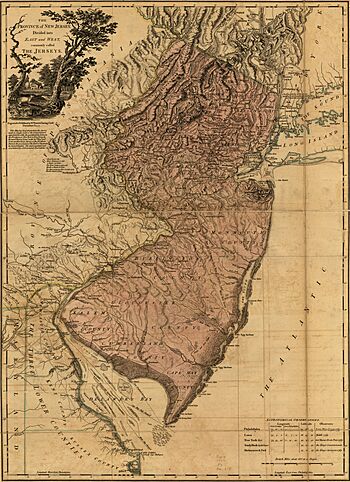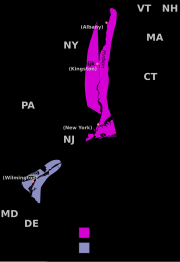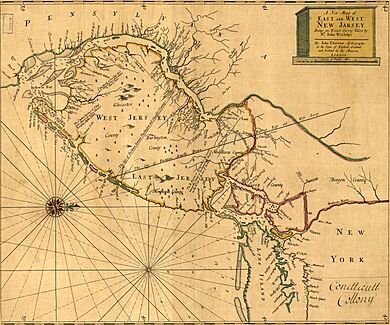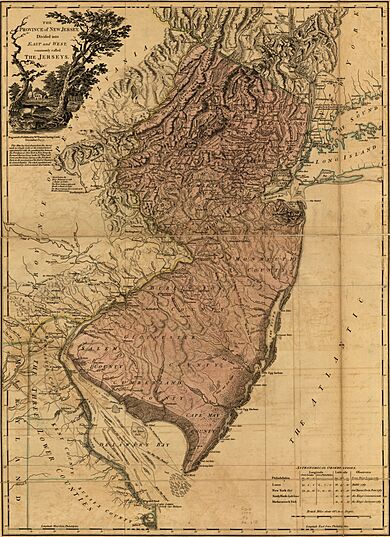Province of New Jersey facts for kids
Quick facts for kids
New Jersey
|
|||||||||||||||||
|---|---|---|---|---|---|---|---|---|---|---|---|---|---|---|---|---|---|
| 1664–1673 1702–1776 |
|||||||||||||||||

The Province of New Jersey, Divided into East and West, commonly called The Jerseys,
1777 map by William Faden |
|||||||||||||||||
| Status | Proprietary Colony of England (1664–1673) Royal Colony of England (1702–1707) Royal Colony of Great Britain (1707–1776) |
||||||||||||||||
| Capital | Elizabethtown (1664–1673) Perth Amboy and Burlington (1702–1776) |
||||||||||||||||
| Common languages | English, Dutch | ||||||||||||||||
| Religion | Church of England (Official) | ||||||||||||||||
| Government | Proprietary colony (1664-1673) Royal colony (1702-1776) |
||||||||||||||||
| Lords Proprieter | |||||||||||||||||
|
• 1664-1673
|
Lord Berkeley of Stratton Sir George Carteret |
||||||||||||||||
| Governor | |||||||||||||||||
|
• 1664-1665
|
Richard Nicolls (first) | ||||||||||||||||
|
• 1672-1673
|
John Berry (last) | ||||||||||||||||
| Royal Governor | |||||||||||||||||
|
• 1702-1708
|
Lord Cornbury (first) | ||||||||||||||||
|
• 1763-1776
|
William Franklin (last) | ||||||||||||||||
| Legislature | Council General Assembly Provincial Congress (1775-1776) |
||||||||||||||||
| History | |||||||||||||||||
|
• 1609
|
1664 | ||||||||||||||||
|
• 1666
|
1776 | ||||||||||||||||
| Currency | New Jersey pound | ||||||||||||||||
|
|||||||||||||||||
| Today part of | United States | ||||||||||||||||
| History of New Jersey |
|
|---|---|
 |
|
| Colonial period | |
| American Revolution | |
| Nineteenth century | |
| Twentieth century | |
| Twenty-first century | |
| Timeline of New Jersey | |
The Province of New Jersey was one of the original Middle Colonies in Colonial America. It later became the U.S. state of New Jersey in 1776. Europeans first settled this area as part of New Netherland. However, in 1664, the English took control after Fort Amsterdam surrendered. New Jersey then became a proprietary colony, which meant it was ruled by private owners. The English named it after the island of Jersey in the English Channel.
For a short time in 1673–1674, the Dutch Republic took back control. After that, the province was split into two parts: East Jersey and West Jersey. These two parts stayed separate until 1702. In 1702, they were joined together again as a royal colony. The original borders of the province were a bit larger than New Jersey is today. They even included a small part of what is now New York. The final border was set in 1773.
Contents
How New Jersey Began
The area that became the Province of New Jersey was first settled by Europeans in the 1610s. It was part of a Dutch colony called New Netherland. In September 1664, the English took control of Fort Amsterdam. This gave them power over the entire Mid-Atlantic region during the Second Anglo-Dutch War. The English said they had the right to the land because John Cabot had discovered it for England's King Henry VII. However, they likely wanted to control the valuable trade in the North Atlantic.
Peter Stuyvesant, the Dutch leader, could not gather enough soldiers to fight. So, he gave up control of the colony. He made sure that the Dutch settlers' property rights, inheritance laws, and freedom of religion were protected. After the Dutch surrendered, Richard Nicolls became the deputy-governor. He was in charge of New Amsterdam and the rest of New Netherland. This included settlements like Bergen and those along the Delaware River.
East and West Jersey: Two Separate Colonies
From 1674 to 1702, the Province of New Jersey was divided into two distinct areas: East Jersey and West Jersey. Each of these parts had its own governor. They also had their own rules, called constitutions. West Jersey adopted its constitution in 1681, and East Jersey adopted its in 1683.
The exact line between West and East Jersey was often debated. This border reached the Atlantic Ocean just north of today's Atlantic City. You can still see this border in the county lines today. For example, it runs between Burlington and Ocean counties. It also runs between Hunterdon and Somerset counties. The line, first drawn by George Keith, goes north-northwest. It starts from the southern part of Little Egg Harbor Township. It passes just north of Tuckerton. Then it reaches a point on the Delaware River, just north of the Delaware Water Gap.
Later, a document called the 1676 Quintipartite Deed helped to reduce these arguments. More accurate surveys and maps were made to solve property disputes. This led to the Thornton Line around 1696. Then came the Lawrence Line around 1743. The Lawrence Line was finally accepted as the official border for legal reasons.
New Jersey Becomes a Royal Colony
On April 17, 1702, the two parts of New Jersey were joined together. This happened under the rule of Queen Anne. New Jersey then became a royal colony. This meant it was directly controlled by the British Crown.
Edward Hyde, Lord Cornbury, became the first governor of the united royal colony. However, he was not a good leader. He was known for being corrupt, taking bribes, and making bad land deals. Because of this, Lord Cornbury was called back to England in 1708.
After Cornbury, New Jersey was again ruled by the governors of New York. But the people of New Jersey were not happy about this. They felt these governors favored New York. Judge Lewis Morris argued strongly for New Jersey to have its own governor. In 1738, King George II agreed. He appointed Lewis Morris as New Jersey's separate governor.
The New York–New Jersey Border Conflict
The New York – New Jersey Line War was a series of small fights and raids. These conflicts lasted for over 50 years, from 1701 to 1765. They happened because of a disputed border between the Province of New York and the Province of New Jersey. Border disputes were common in the early days of the colonies. They often started because of unclear land claims.
Sometimes, people didn't know the exact borders. Other times, they simply ignored them. These issues led to conflicts involving local settlers. In the biggest of these arguments, about 210,000 acres (850 km²) of land were at stake. A royal commission finally settled the conflict in 1769.
Steps Towards Independence
The Provincial Congress of New Jersey was a temporary government. It was formed in New Jersey during the early part of the American Revolution. It first met in 1775. Representatives from all thirteen of New Jersey's counties were there. Their goal was to take over from the royal governor.
New Jersey's First State Constitution
New Jersey's first state constitution was approved on July 2, 1776. The American Revolutionary War was already happening. General George Washington had recently lost a battle in New York. This put New Jersey in danger of being invaded.
The 1776 New Jersey State Constitution was written very quickly. It took only five days to draft. It was then approved within two more days. Its purpose was to create a temporary government. This helped prevent New Jersey from falling into chaos. Among other things, this constitution gave the right to vote to unmarried women and Black people who owned enough property.
Judicial System in Colonial New Jersey
The Supreme Court was created in 1704. It met in two different locations: Perth Amboy and Burlington. The court included a chief justice, a second judge, and several associate judges.
- Chief justices
| Incumbent | Tenure | Notes | |
|---|---|---|---|
| Took office | Left office | ||
| Roger Mompesson | Oct 1704 | 1709 | |
| Thomas Gordon | April 28, 1709 | 1709 | |
| Roger Mompesson | 1709 | February 14, 1710 | |
| David Jamison (politician) | 1710 | 1723 | |
| William Trent | November 23, 1723 | December 25, 1724 | |
| Robert Lettis Hooper | January 2, 1725 | 1728 | |
| Thomas Farmar | 1728 | 1728 | |
| Robert Lettis Hooper | 1729 | 1738 | |
| Robert Hunter Morris | March 17, 1739 | January 27, 1757 | disputed resignation in 1754, left for England 1757 |
| William Aynsley | February 16, 1757 | May 1758 | |
| Robert Hunter Morris | 1761 | January 27, 1764 | restored to office |
| Charles Reade | February 20, 1764 | 1764 | |
| Frederick Smyth | October 17, 1764 | 1766 | |
Images for kids
See also
 In Spanish: Provincia de Nueva Jersey para niños
In Spanish: Provincia de Nueva Jersey para niños






